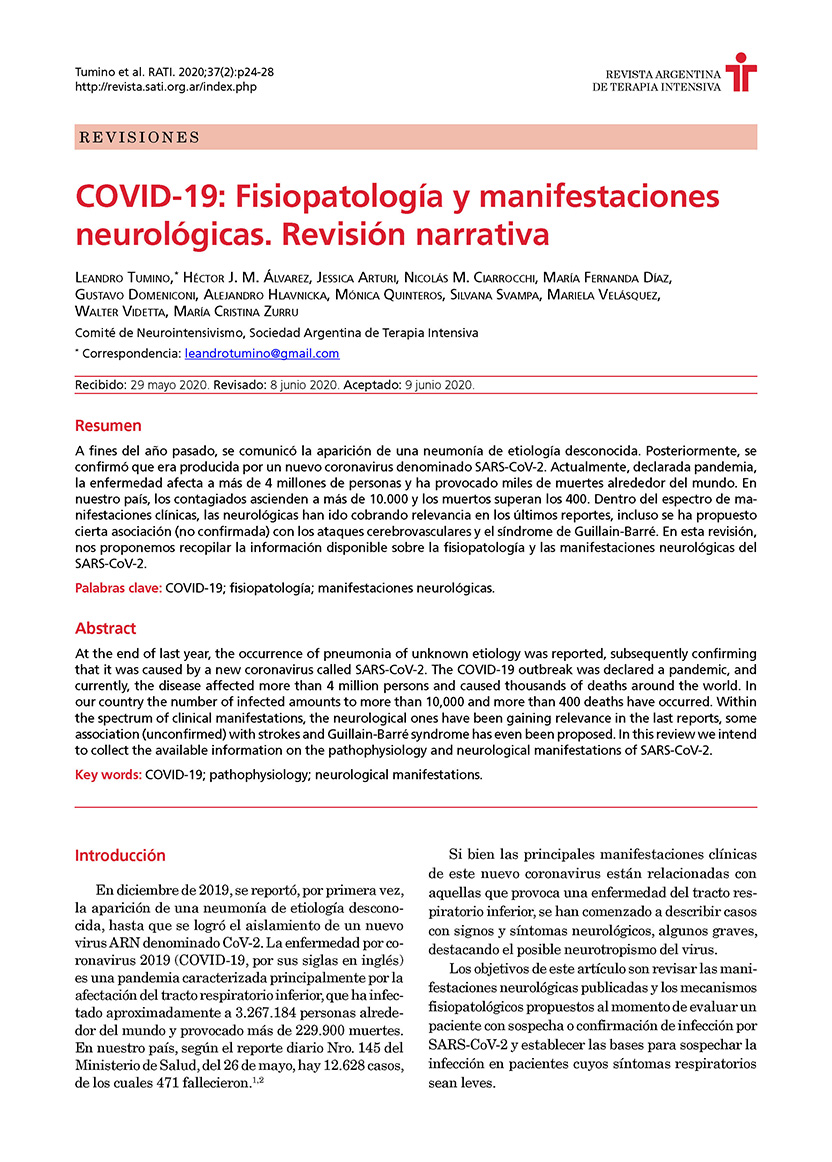Resumen
A fines del año pasado, se comunicó la aparición de una neumonía de etiología desconocida. Posteriormente, se confirmó que era producida por un nuevo coronavirus denominado SARS-CoV-2. Actualmente, declarada pandemia, la enfermedad afecta a más de 4 millones de personas y ha provocado miles de muertes alrededor del mundo. En nuestro país, los contagiados ascienden a más de 10.000 y los muertos superan los 400. Dentro del espectro de manifestaciones clínicas, las neurológicas han ido cobrando relevancia en los últimos reportes, incluso se ha propuesto cierta asociación (no confirmada) con los ataques cerebrovasculares y el síndrome de Guillain-Barré. En esta revisión, nos proponemos recopilar la información disponible sobre la fisiopatología y las manifestaciones neurológicas del SARS-CoV-2.
Referencias
Huang C, Wang Y, Li X, et al. Clinical features of patients infected with 2019 novel coronavirus in Wuhan, China. Lancet 2020; 395(10223): 497-506. https://doi.org/10.1016/S0140-6736(20)30183-5
Coronavirus disease (COVID-19) Pandemic. World Health Organization, Geneva, mayo 2, 2020. Disponible en: https://www.who.int/ emergencies/diseases/novel-coronavirus-2019. (Consulta: 2 de mayo, 2020)
Li YC, Bai WZ, Hashikawa T. The neuroinvasive potential of SARS-CoV2 may be at least partially responsible for the respiratory failure of COVID-19 patients. J Med Virol 2020; 92(6): 552-555. https://doi.org/10.1002/jmv.25728
Hamming I, Timens W, Bulthuis ML, et al. Tissue distribution of ACE2 protein, the functional receptor for SARS coronavirus. A first step in understanding SARS pathogenesis. J Pathol 2004; 203(2): 631-637. https://doi.org/10.1002/path.1570
To KF, Lo AW. Exploring the pathogenesis of severe acute respiratory syndrome (SARS): the tissue distribution of the coronavirus (SARS-CoV) and its putative receptor, angiotensin-converting enzyme 2 (ACE2). J Pathol 2004; 203(3): 740-743. https://doi.org/10.1002/path.1597
Li K, Wohlford-Lenane C, Perlman S, et al. Middle east respiratory syndrome coronavirus causes multiple organ damage and lethal disease in mice transgenic for human dipeptidyl peptidase 4. J Infect Dis 2016; 213(5): 712-722. https://doi.org/10.1093/infdis/jiv499
Netland J, Meyerholz DK, Moore S, et al. Severe acute respiratory syndrome coronavirus infection causes neuronal death in the absence of encephalitis in mice transgenic for human ACE2. J Virol 2008; 82(15): 7264-7275. https://doi.org/10.1128/JVI.00737-08
Matsuda K, Park CH, Sunden Y, et al. The vagus nerve is one route of transneural invasion for intranasally inoculated influenza a virus in mice. Vet Pathol 2004; 41(2): 101-107. https://doi.org/10.1354/vp.41-2-101
Wu Y, Xu X, Chen Z, et al. Nervous system involvement after infection with COVID-19 and other coronaviruses. Brain Behav Immun 2020; S0889-1591 (20) 30357-3. https://doi.org/10.1016/j.bbi.2020.03.031
Asadi-Pooya AA, Simani L. Central nervous system manifestations of COVID-19: A systematic review. J Neurol Sci 2020; 413: 116832. https://doi.org/10.1016/j.jns.2020.116832
Metlay JP, Waterer GW, Long AC, et al. Diagnosis and treatment of adults with community-acquired pneumonia: an official clinical practice guideline of the American Thoracic Society and Infectious Disease Society of America. Am J Respir Crit Care Med 2019; 200(7): e45-e67. https://doi.org/10. 1164/rccm.201908-1581ST.
Mao L, Jin H, Wang M, et al. Neurologic manifestations of hospitalized patients with coronavirus disease 2019 in Wuhan, China. JAMA Neurol 2020; e201127. https://doi.org/10.1001/jamaneurol.2020.1127
Helms J, Kremer S, Merdji H, et al. Neurologic features in severe SARS-CoV-2 infection. N Engl J Med 2020; 382(23): 2268.2270. https://doi.org/10.1056/NEJMc2008597
Moriguchi T, Harii N, Goto J, et al. A first case of meningitis/encephalitis associated with SARS-Coronavirus-2. Int J Infect Dis 2020; 94: 55-58. https://doi.org/10.1016/j.ijid.2020.03.062.
Xu Z, Shi L, Wang Y, et al. Pathological findings of COVID-19 associated with acute respiratory distress syndrome. Lancet Respir Med 2020; 8(4): 420-422. https://doi.org/10.1016/S2213-2600(20)30076-X
Li Y, Wang M, Zhou Y, et al. Acute cerebrovascular disease following COVID-19: a single center, retrospective, observational study (3/3/2020). Disponible en: https://ssrn.com/ abstract¼3550025. (Consulta: 3 de mayo, 2020).
Zhou F, Yu T, Du R, et al. Clinical course and risk factors for mortality of adult inpatients with COVID-19 in Wuhan, China: a retrospective cohort study. Lancet 2020; 395(10229): 1054-1062. https://doi.org/10.1016/S0140-6736(20)30566-3
Kwee RM, Krdzalic J, Fasen BACM, et al. CT scanning in suspected stroke or head trauma: is it worth to go the extra mile and include the chest to screen for COVID-19 infection? Am J Neuroradiol 2020. https://doi.org/10.3174/ajnr.A6607
Padroni M, Mastrangelo V, Asioli GM, et al. Guillain-Barré syndrome following COVID-19: new infection, old complication? J Neurol 2020; 1-3. https://doi.org/10.1007/s00415-020-09849-6
Camdessanche JP, Morel J, Pozzetto B, et al. COVID-19 may induce Guillain-Barré syndrome. Rev Neurol (Paris) 2020; 176(6): 516-518. https://doi.org/10.1016/j.neurol.2020.04.003.
Alberti P, Beretta S, Piatti M, et al. Guillain-Barré syndrome related to COVID-19 infection. Neurol Neuroimmunol Neuroinflamm 2020; 7(4): e741. https://doi.org/10.1212/NXI.0000000000000741.
Otmani H, Moutawakil B, Rafai MA, et al. Covid-19 and Guillain-Barré syndrome: More than a coincidence! Rev Neurol (Paris) 2020; 176(6): 518-519. https://doi.org/10.1016/j.neurol.2020.04.007.
La revista no retiene los derechos de reproducción (copyright) por lo que los autores pueden volver a publicar sus trabajos con la sola mención a la fuente original de publicación.

